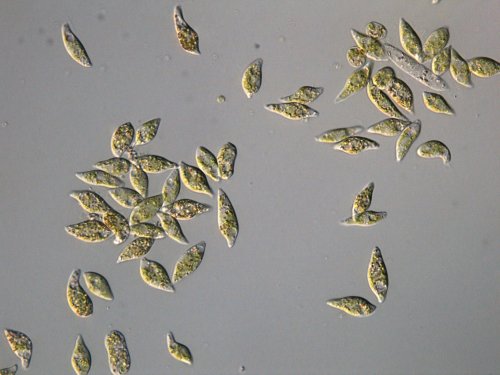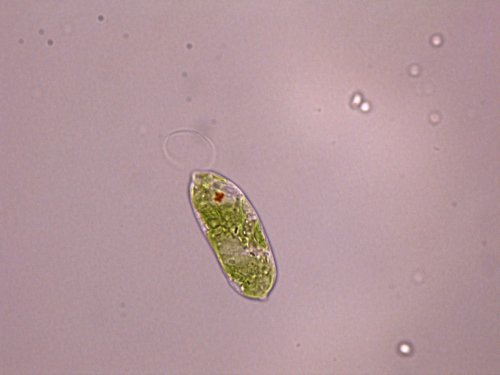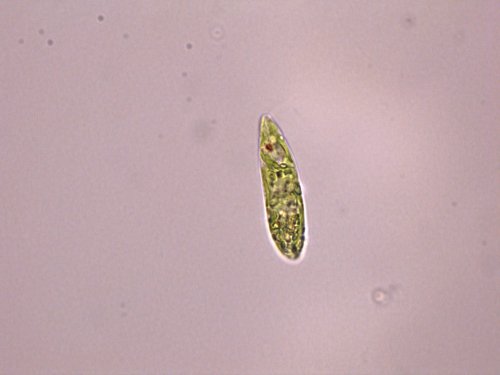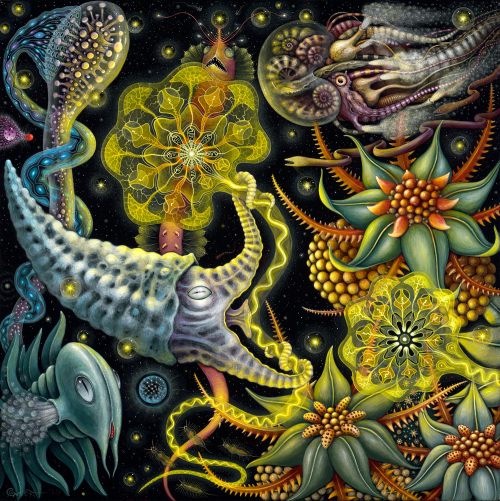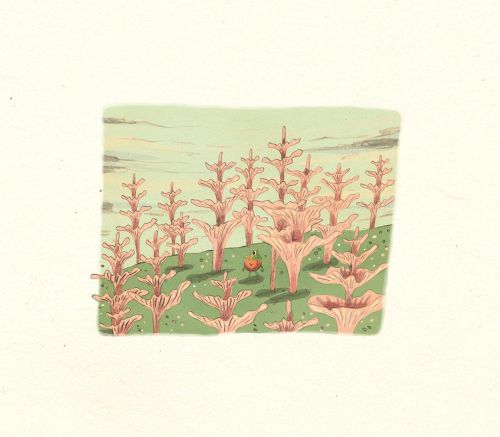#microorganisms
Water flea
Cladocera (water fleas) and air bubbles.
Active organisms.
Algae and rotifers swimming about.
Rotifers and other organisms.
Larvae and algae.
Swimming away
Close up of larvae from creek water sample.
Larvae fighting other organisms. Protective of food.
Microorganisms swimming
Rotifers, possibly.
Super algae
The image above shows Euglena gracilis, a single-cell algae lurking in garden ponds.
It might not look like much, but scientists at the John Innes Centre have uncovered genes in the algae which could be used to make natural products.
Professor Field and team found that Euglenahas at least 32,000 genes – significantly more than humans who have around 21,000.
Euglena creates many well-known, valuable natural products including vitamins and a type of sugar which is reported to have anti-HIV effects.
The genetic information in this somewhat simple algae is in fact enormous.
Around 60% of the genes found are new and unclassified, which means Euglena could be a source of entirely new medicines and fuels for the future.
Image credit: Professor Rob Field, John Innes Centre
Post link
This is IDIOTGOD - The original painting is from 2012. the animation is new.

This is ANTAGONY, a painting from 2010. The title is derived from antagonism. There seems to be a lot of that going around. Are people more violent than they used to be? Or is it the negativity bias of the media that makes it seem that way? ~ https://linktr.ee/rsconnett
‘MICROVERSE v4’ in motion

TRANSVOLUTION from 2011
This is my painting SOMNAMBULANT from 2012. This animated version has been created by the outstanding animator, @m4wave. This painting is inspired by dreams, sleepwalking, and hypnagogia. (see previous post) I began sleepwalking when I was around 8. For that, my parents sent me to a shrink who taught me to remember my dreams. That was the beginning of my interest in dreams. ☠️
WAR MACHINE - Original painting done in 2007, ~ Animated version completed May, 2022, with the gifted animation assistance of @shiroartstudio

MEMORIAL DAY WEEKEND SALE ON NOW! ~ Starting now take 25% OFF EVERYTHING IN MY SHOP Until the end of Memorial Day Monday, 5/30/22, USE CODE MD2022 at checkout for 25% OFF on everything at https://rsconnettart.bigcartel.com/
Quiero comenzar con esta nueva etapa para la cuenta compartiendo con ustedes unas notas rápidas sobre un artículo muy interesante sobre “El microbioma en la piel humana”
I want to start this new stage for the account by sharing with you some quick notes about a very interesting article about “The microbiome in human skin”




Have you seen ‘The Fungies’ ? @thefungies.official Created by the amazing @stephenpneary and streaming on HBO Max!
I had the absolute pleasure of working on some concept art in it’s first appearance as ‘the Fancies’
You can see more of the show’s development artwork over at @thefungies.official . Here’s one of the sketches I did for ‘The Fancies’ a few years ago. Seth, the main character of THE FUNGIES, is having an explore! #thefancies #thefungies #illustration #conceptart #artistsoninstagram #artistsofinstagram #lichen #mushrooms #microorganisms
https://www.instagram.com/p/CFRdYP7lRO5/?igshid=1i8xaxumxbudt
Post link
On Instagram, you can find plenty of photos of juicy hamburgers, soothing ocean views, and hashtags galore, among other things. What you wouldn’t expect to find are photos of our favorite thing: microbes–until now, that is!
Pondlife_pondlife, an account run by Sally Warring, a PhD student at NYU, is only eight months old, but already has almost 9,000 followers, and has just been reported on by The Atlantic. According to the account’s bio, Warring is “documenting the single cellular life of New York City (and occasionally beyond), one pond at a time.”
Warring takes samples from various waters in New York City to see the types of microorganisms that lurk within. She later creates the images using her iPhone and a powerful Leica Dm1000 compound microscope at the NYU Center for Genomics and Systems Biology, and uploads the stunning results to pondlife_pondlife.
Microorganisms are what drove Warring to pursue scientific research as a career. She wanted to convey her passion to an audience that doesn’t have a background in biology. In that sense, her mission has become to educate and entertain at the same time (mission accomplished, we’d say!). Furthermore, Warring shows the Instagram world, with her feed of what she calls “urban phycology,” that there are vastly more life forms in NYC than pigeons, rats, and humans always on-the-go.
Follow Sally’s adventures pond to pond at pondlife_pondlife, and read more at the link!
Post link

